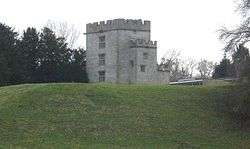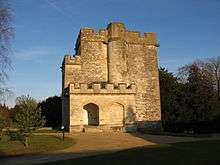Newton St Loe Castle
Newton St Loe Castle was a fortified manor house in the village of Newton St Loe, Somerset, England.
| Newton St Loe Castle | |
|---|---|
| Newton St Loe, Somerset | |
 Keep of Newton St Loe Castle | |
 Newton St Loe Castle | |
| Coordinates | 51.3733°N 2.4410°W |
| Grid reference | grid reference ST694639 |
| Type | Fortified manor house |
| Site information | |
| Owner | Bath Spa University |
| Site history | |
| Materials | Stone |
Details

The lands around Newton St. Loe (Newton Seyntloo) were inherited through marriage from the de Paveley's, a Norman knight from Westbury, Wiltshire. John de Paveley died without an heir, so his lands passed through marriage to John de Sancto Laudo, another family of knight who gained recognition for his actions at Acre during the Crusades. Newton St Loe Castle was originally built as a fortified manor house, probably in the 12th century, surrounded by Newton Park, then a medieval deer park. During its time the castle was known as St. John's keep, for apparently holding King John under arrest by William de Sancto Laudo. [1] At the start of the 14th century, a keep was built on the site as part of a wider programme of work by the St Loe family, creating a rectangular, courtyard castle with four corner towers, protected by a ditch on three sides.[2] In 1375 the site was inherited by Elizabeth, the last of the St Loe family, who married William, Baron Botreaux.[3] Sir Walter Hungerford built a new gatehouse at the castle during the first half of the 15th century, which features turrets, machicolations and an early gunport.[4]
In the 19th century the castle and the surrounding park were heavily landscaped to produce the current country house and gardens; only the renovated keep and the gatehouse survive intact, although a nearby mound marks one of the corner towers of the 14th-century castle.[5] Today the site is leased by Bath Spa University and both the keep and the gatehouse are scheduled monuments, holding a Grade 1 listed building status.[6]
During the 1970-80's the castle was home to the Religious Studies department of Bath College of Higher Education (now Bath Spa University).
References
- St Loes Castle Archived 2014-02-28 at the Wayback Machine, National Monuments Record, English Heritage, accessed 16 July 2011; Dunning, pp.61-2.
- Pettifer, p.222; Youngs and Clark, p.200; Castle Keep in the Grounds of Newton Park, Images of England, accessed 16 July 2011.
- Dunning, pp.61-2.
- Pettifer, p.222; Kenyon, p.83.
- St Loes Castle Archived 2014-02-28 at the Wayback Machine, National Monuments Record, English Heritage, accessed 16 July 2011.
- Newton St Loe, Gatehouse webpage, accessed 16 July 2011.
Bibliography
- Dunning, Robert. (1995) Somerset Castles. Tiverton, UK: Somerset Books. ISBN 978-0-86183-278-1.
- Kenyon, John R. (1977). "Early Gunports," Fort 4, pp74–84.
- Pettifer, Adrian. (2002) English Castles: a Guide by Counties. Woodbridge, UK: Boydell Press. ISBN 978-0-85115-782-5.
- Youngs, Susan M. and John Clark. (1981) "Medieval Britain in 1980," Medieval Archaeology 25, pp. 166–288.
